Amedeo Modigliani, a life for art. Biography and major works
Amedeo Modigliani (Leghorn, 1884 - Paris, 1920) falls into a category of artists who decided to leave their native country and move to France. Paris, at the beginning of the 20th century, was the cradle of culture, of modernity, as well as a place of exchange and updating for poets, sculptors, painters, and philosophers. In this lively and flourishing climate, artists from all over Europe arrived, such as the Romanian Constâtin BrâncuÈ™i (Pestisani, 1876 - Paris, 1957), the Russian Marc Chagall (Vitebsk, 1887 - Saint Paul de Vence, 1985), the Russian Chaïm Soutine (Smiloviči, 1893 - Paris, 1943) and the Italian Amedeo Modigliani, who came into contact with already established personalities such as Pablo Picasso (Malaga, 1881 - Mougins, 1973), Georges Braque (Argenteuil, 1882 - Paris, 1963), Henri Matisse (Le Cateau-Cambrésis, 1869 - Nice, 1954), the poet Guillaume Apollinaire, André Derain and many others. Also in Paris, during the same years, some of the main exponents of Futurism stayed alternately, such as Umberto Boccioni, Gino Severini, Carrà, and Ardengo Soffici, further demonstrating the great vitality of the environment in which not necessarily everyone came into contact with each other, but could benefit from the fervent cultural temperament.
The freedom of press and action that the city of Paris offered favored the succession of that trail of artists who were not satisfied with the opportunities that their native country offered them. Art history textbooks often classify BrâncuÈ™i, Chagall, Soutine and Modigliani as belonging to the “School of Paris”, although theirs was a common way of living and thinking, rather than a school. Another aspect they had in common, besides being foreign artists in France, was that they lived in the same Parisian neighborhood, namely Montparnasse, in a building nicknamed “the beehive,” used as a studio for artists who had not enlisted in the war; their participation in the Salon, a famous exhibition organized in Paris as early as 1667, was also a factor of common agreement.
An existence, Modigliani’s, was not a particularly fortunate one: the Leghorn artist of Jewish descent was in fact stricken, even at an early age, by serious health problems. And his choice to be an artist by profession was swift and without second thoughts.
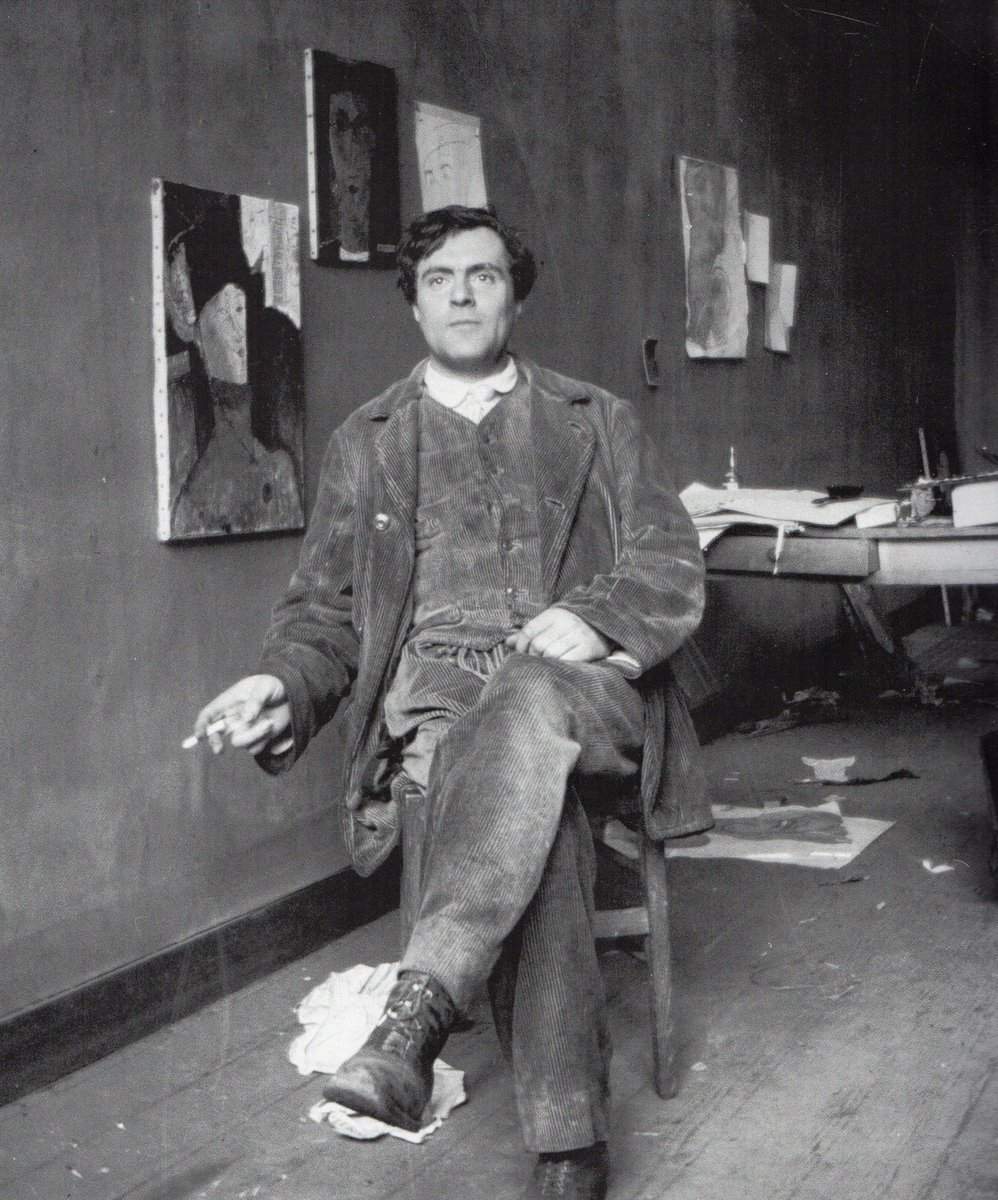 |
| Amedeo Modigliani in his studio, 1915 photograph by Paul Guillaume |
Biography of Amedeo Modigliani
Born in Livorno on July 12, 1884, Amedeo Modigliani (affectionately called “Dedo” by friends, and later “Modì” in France) spent his formative years in Italy. The artistic guidance of Guglielmo Micheli, a Macchiaioli-trained artist (the Macchiaioli were a group of Tuscan artists active in the late 19th century, who painted by juxtaposing blobs of color) is crucial to his next step: his decision to leave Livorno in 1902 to study at the Scuola Libera di Nudo in Florence. In 1903 it was the turn of Venice, at the Institute of Fine Arts, where he did not fail to follow the study of Venetian Renaissance painters, such as Giorgione, Titian Vecellio, and Tintoretto. If these are the fundamental experiences for his education, so are the visits to the major museums in Milan, Rome, Pisa, before leaving for France.
In 1906 he was in Montmartre where he rented a studio on rue Caulaincourt. Shortly thereafter he moved to the aforementioned Montparnasse, a haven for young painters, sculptors, and engravers. Although Modigliani’s interests veered in the direction of the Symbolists and also looked to Gustav Klimt (Baumgarten, 1862 - Vienna, 1918), Paul Gauguin (Paris, 1848 - Atuona, 1903) and the Picasso of the Blue period, his personality did not fail to imprint his works with a unique and unmistakable style. Initially, he worked on painting, approaching the brushstrokes of Paul Cézanne; not satisfied with his work, he then moved on to sculpture, without, however, abandoning easel painting altogether. The pictorial production is articulated from the first portraits aimed at family members, but what has come down to us is not sufficient to adequately reconstruct the early years of the artist’s career. Greater, on the other hand, are the sketches made in France to friends, in cafes, where the artist often indulged in the use of alcohol and drugs, as many did at that time. He certainly had a decisive personality: if a work was not to his taste, he destroyed it.
He returned to painting in 1914 with a new awareness, due in part to a fortunate meeting with Paul Guillaume (Paris, 1891 - 1934), a young French dealer, who advised Modigliani to devote himself to painting, which was more attractive to the art market than sculpture. He is also the first to sponsor the young Amedeo, but this is not enough to achieve fame, which will only properly occur towards the end of his career and even more so after his death. However, this is not the only motivation that leads the artist to return to painting: worsening health conditions do not allow him to deal with difficult materials, such as limestone, which he often chose and used. The last, but crucial, promoter of Modigliani’s art was the Polish Leopold Zborowski (Warsaw, 1889 - Paris, 1932), a writer and art dealer who in 1916 asked for exclusivity on his works in exchange for an annual franc fee, as well as hospitality in his various homes.
In 1917, Modigliani met the very young painter Jeanne Hébuterne (Meaux, 1898 - Paris, 1920): the two fell in love and moved in together on the rue de la Grande-Chaumière in Montparnasse. At the same time, the Berthe Weill Gallery in Paris organized Modigliani’s first exhibition, which was, however, closed the same day of the opening, for outrage against public morals (nudes do indeed create problems). In 1918 the artist’s precarious health, undermined by tuberculosis, worsened, and he was therefore forced to leave Paris and move south in order to take advantage of the better climate. In the summer he therefore stayed between Nice and Cagnes-sur-Mer. On November 29, 1918, Jeanne, daughter of Amedeo and Jeanne Hébuterne, was born: her daughter’s birth was kept secret from her family, who frowned upon her relationship with the painter (she would be discovered by her brother André, however, and relations with the family would become decidedly stormy). In May 1919 Amedeo returned to Paris, and the following month he was joined by Jeanne, who turned out to be pregnant again. In August, the artist exhibited in London, receiving critical acclaim, but in the last months of the year his health experienced a further collapse.
In January, the artist fell ill with pneumonia and slipped into a coma: she died on January 24 at 8:45 p.m., at the Hôpital de la Charité. The next day, at 3 a.m., Jeanne, eight months pregnant but devastated by the loss of Amedeo, killed herself by jumping from her bedroom window. The two lovers today rest together in the Père Lachaise cemetery in Paris.
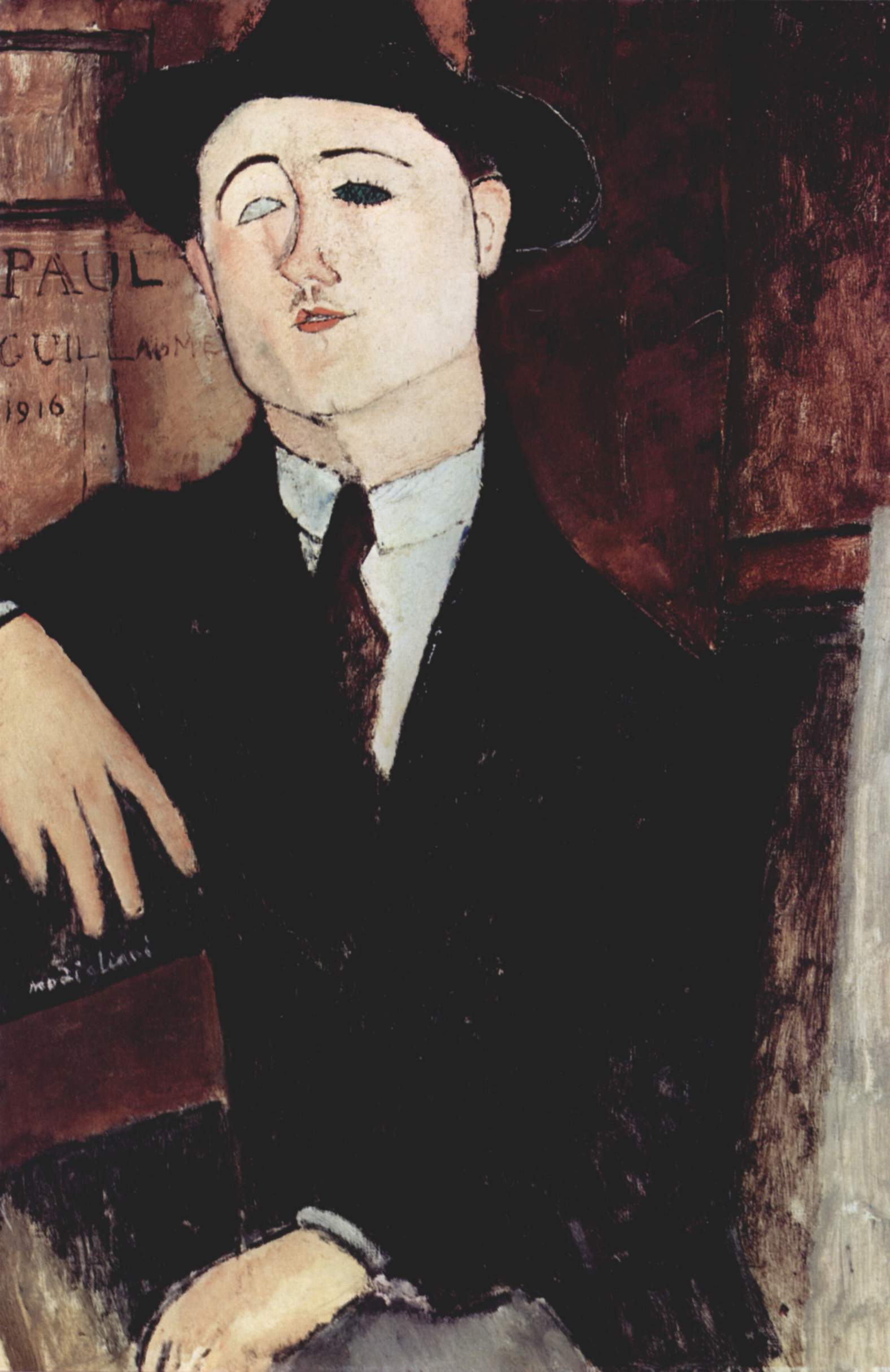 |
| Amedeo Modigliani, Portrait of Paul Guillaume (1916; oil on canvas, 81 x 54 cm; Milan, Museo del Novecento) |
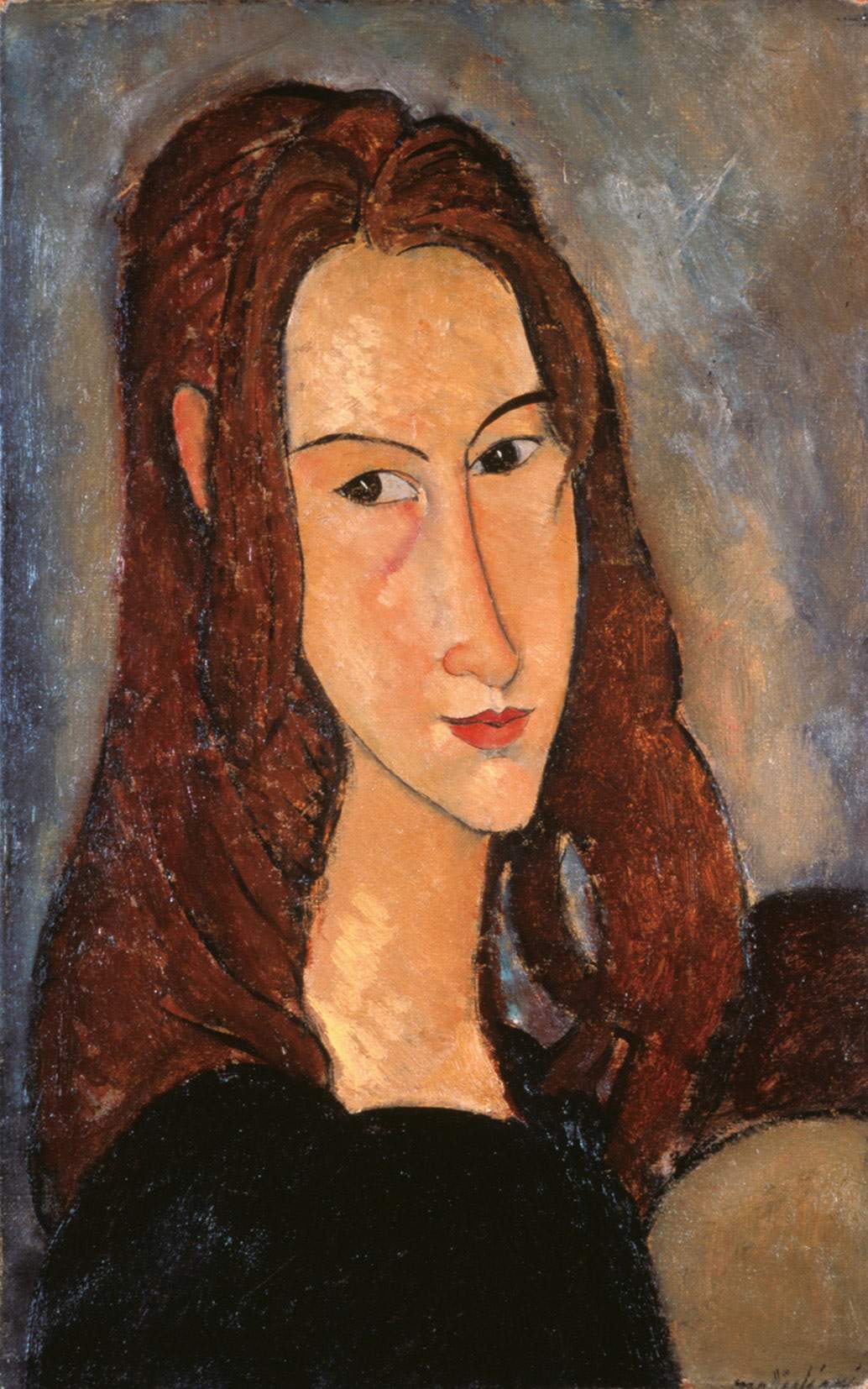 |
| Amedeo Modigliani, Jeune fille rousse (Jeanne Hébuterne) (1918; oil on canvas, 46 x 29 cm; Jonas Netter collection) |
 |
| Amedeo Modigliani, Seated Nude (Beatrice Hastings?) (1916; oil on canvas, 92 x 60 cm; London, Courtauld Gallery) |
Modigliani’s art, from his acquaintance with BrâncuÈ™i to his last works
Modigliani began to paint in his Livorno in a style similar to that of the Macchiaioli, but his art would change radically after his stay in Paris, and later, as he reached maturity, a further change at the stylistic level would be observed, due to the settling of operational choices. The sum of influences that will characterize his production will lead him to a production that can hardly be pigeonholed into a precise genre: his is an art characterized by simplicity and formal purity. Fundamental to Modigliani’s art was his acquaintance with Constântin BrâncuÈ™i, which led the Italian to devote himself almost entirely to sculpture, although he would later be forced by his illness to return to painting, sculpture being a much more tiring and debilitating activity for the artist’s physique. Unmistakable of the sculptural production are the peculiar elongated figures, but also the reduction to the minimum, in terms of simplicity of lines and forms. These elements of formal purity are inferred precisely from the Romanian sculptor’s art.
In the Head of c. 1911-12 the artist’s willingness to deform what should be a normal human face is very evident. The proportions are totally upset, in favor of a flattening or elongation of nose, mouth, eyes. Everything is strained toward schematization, without any kind of decoration. The semblances Modigliani’s works take on echo African masks, theprimitive art already much investigated by the French fauves, a group of artists active in 1905-07, as well as the Cubists, who were united by the geometrization of forms. However, his painting, made up of grace, pronounced contours, and a tendency to elongate proportions, also denotes the inspiration that the artist draws from his cultural background, and in particular from the great Tuscan artists of the past such as Simone Martini (Siena, 1284 - Avignon, c. 1344a.), but also Filippo Lippi (Florence, 1406 - Spoleto, 1469) and Sandro Botticelli (Florence, 1445 - Florence, 1510), author of the famous Primavera preserved in the Uffizi Gallery in Florence.
After abandoning sculpture, the “sculptural” elements of his production switched to painting, so much so that the subjects of his paintings soon began to reflect the quests for formal purity that Modigliani was following in sculpture. This is also evident in his numerous portraits, where the subjects are rendered with schematic forms and according to a geometrization aimed at conveying to the viewer the most recognizable elements of the subject’s connotations, but are also characterized by an extraordinary acuity in their psychological penetration. With other works, such as his famous nudes, Amedeo Modigliani will also succeed in achieving extraordinarily intense and free, as well as sensual, results.
Modigliani does not, in fact, belong to a specific current, nor has he himself ever claimed to have drawn inspiration from the great masters. On the contrary, he explicitly chooses not to approach either the Futurist avant-garde, let alone the French avant-garde. But his gaze and attention to the trends then circulating in metropolitan Paris at the beginning of the twentieth century is unquestionable. His work is in fact isolated from the various trends. However, critics have always been divided on his account: read also an in-depth look at the art historical importance of Amedeo Modigliani.
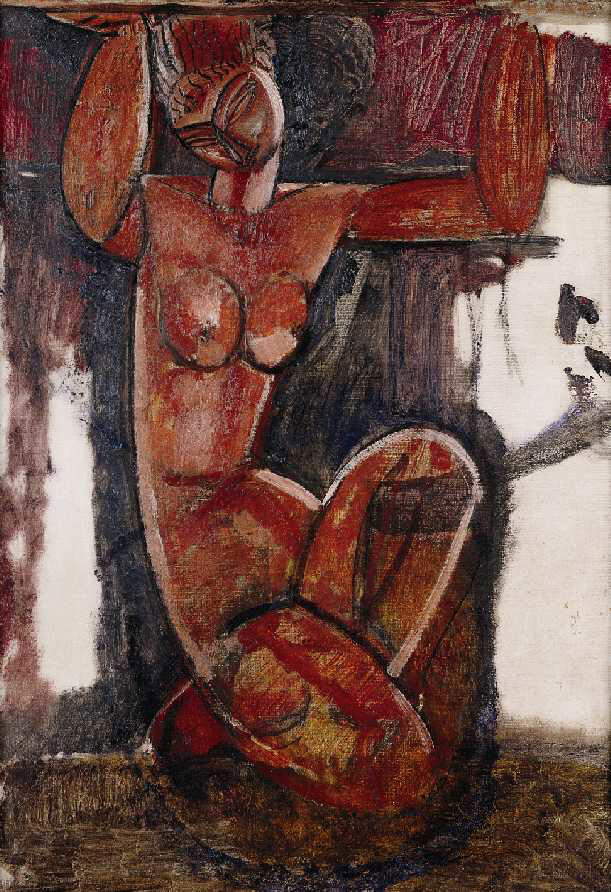 |
| Amedeo Modigliani, Caryatid (1911-1912; oil on canvas, 77.5 x 50 cm; Düsseldorf, Kunstsammlung Nordrhein-Westfalen) |
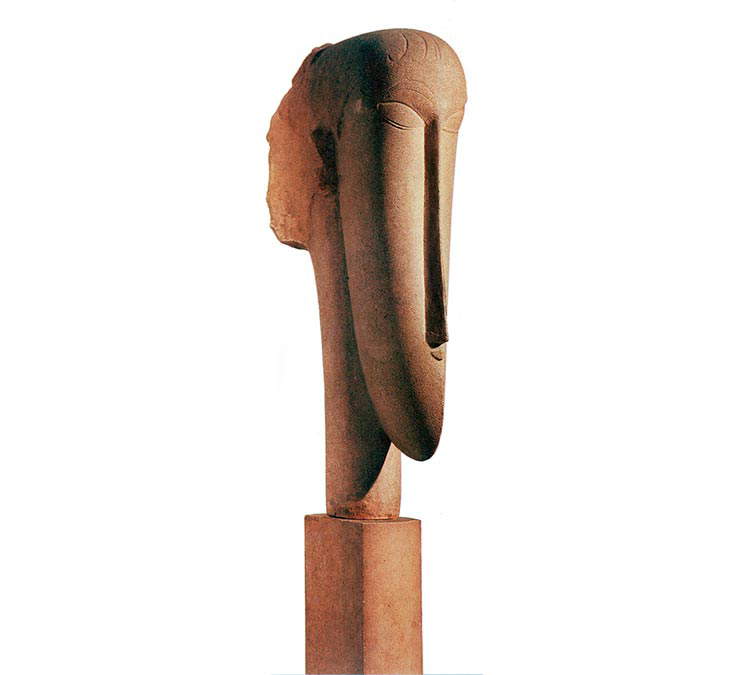 |
| Amedeo Modigliani, Head (1911-12; limestone, 89 cm; London, Tate Modern) |
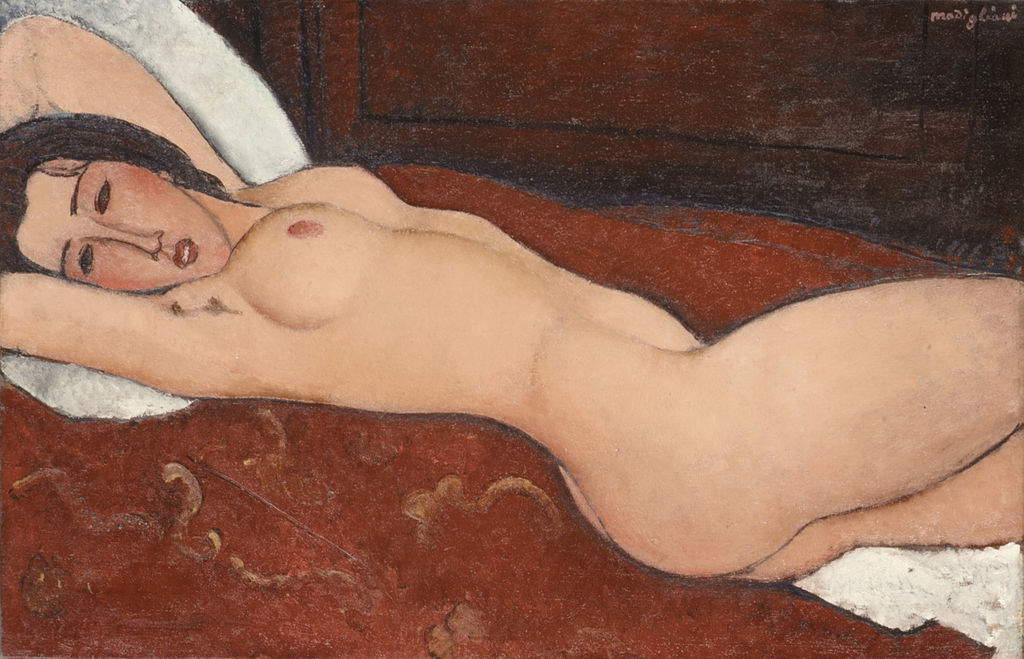 |
| Amedeo Modigliani, Reclining Nude (1917; oil on canvas, 60.6 x 92.7 cm) |
The Modigliani “Fakes”
Modigliani enjoyed success at the end of his career; notable public acclaim, esteem in colleagues achieved internationally, but all this increased even more after 1920. The painter and critic Ardengo Soffici (Rignano sull’Arno, 1879 - Vittoria Apuana, 1964) wrote in the Florentine magazine La Voce, in 1912: “he is for me the greatest, the most complete painter of our time[...]. it is enough to see his landscapes, to feel how irresistibly the two images of youth and spring preside over his creation. And in these a gushing of saps, a fluctuation of airy verdure, a breezy morning blondness, where the sod swells, flakes, and sudden flowers bloom and open with splendor.”
Following his tragic death, after which his companion and painter Jeanne Hébeterne also took her own life, reproductions of his works began to circulate, followed by “legends” and stories about a dubious way of leading his existence. It is often told that his illness worsened precisely because of drug and alcohol abuse. The question of Modigliani’s forgeries is as complex and intricate as ever. Why is he considered “probably the most forged author in the history of art”?
The reasons for the appearance of so many reproductions, stem partly from the artist’s own way of proceeding, but also from the temperance of his personality. Moreover, not all of his works are signed by the same, making it even more difficult to distinguish between an original and a forgery. Another problem is due to the fact that one of his closest friends, Polish artist Moïse Kisling (Krakow, 1891 - Sanary-sur-Mer, 1953), completed some unfinished works. A gesture made in good faith, but one that has fueled the enormous difficulties over the attribution of Modigliani’s works.
Throughout history many scholars have been mistaken several times about attributing works to the artist’s hand, and for all these reasons, but also and above all because of the presence of forgers, people who imitate works by famous artists, passing them off as originals, in order to sell them as such, an extremely murky market has developed around Modigliani, and the artist is still the subject of numerous scandals today. To date, there are just over three hundred works attributed to him with certainty, but around one thousand two hundred are circulating in the art market. On the artist, however, studies continue, and further study of the “Modigliani Legal Archives,” a holdings of more than 6,000 items including documents, notes, drawings and more, could provide new answers.
Where to see Modigliani’s works
Several museums in many Italian cities house works by Amedeo Modigliani. From the Galleria Nazionale d’Arte Moderna e Contemporanea in Rome (where there is a famous portrait of him of Anna Zborowska, Léopold’s wife), to Milan, where it is possible to see some of his paintings either at the Pinacoteca di Brera or in the Museo del Novecento, and then again at the Galleria d’Arte Moderna. Many of Modigliani’s works can be found in France, due to the fact that the artist worked here for most of his career: at the LaM museum in Lille alone there are six works by Modigliani, which have recently been the subject of a survey campaign. By contrast, five important portraits, including that of Paul Guillaume, can be found in Paris at the Musée de l’Orangerie. The most famous nudes, on the other hand, are those held in U.S. collections, particularly the Reclining Nude at the Metropolitan Museum of Art and the nude at the Guggenheim in New York.
A free virtual exhibition tour, promoted last year to mark the centenary of his death, is currently available on the website of the Amedeo Modigliani Institute.
 |
| Amedeo Modigliani, a life for art. Biography and major works |
Warning: the translation into English of the original Italian article was created using automatic tools. We undertake to review all articles, but we do not guarantee the total absence of inaccuracies in the translation due to the program. You can find the original by clicking on the ITA button. If you find any mistake,please contact us.



























